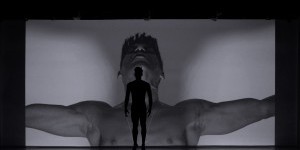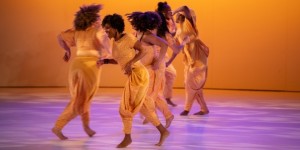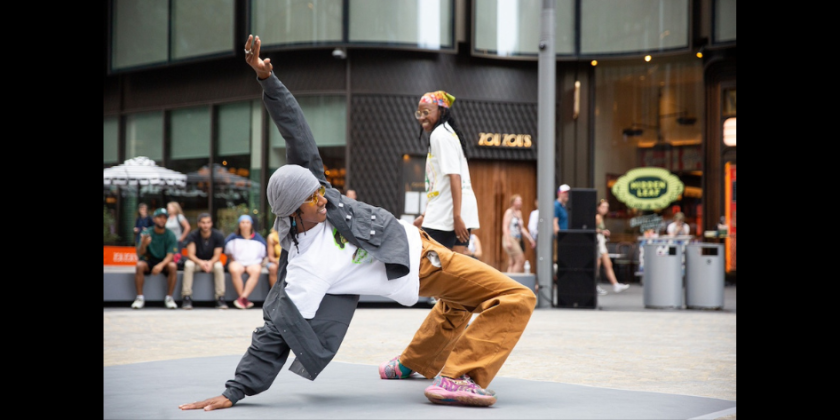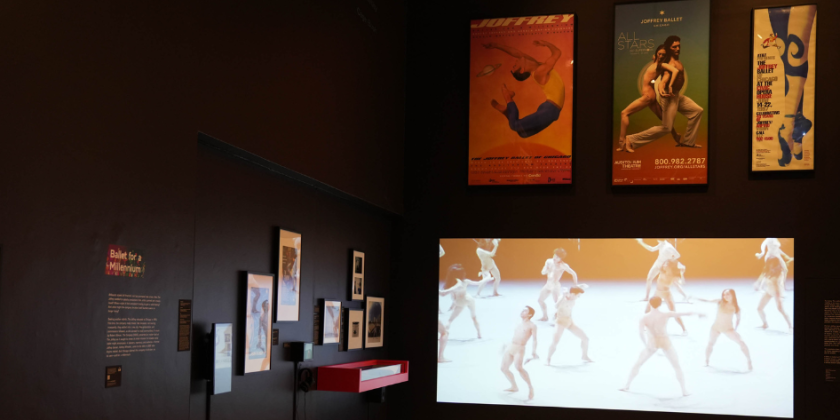DAY IN THE LIFE OF DANCE: Works & Process Presents Martha Graham Dance Company with Baye & Asa

Panel: Amadi “Baye” Washington, Sam “Asa” Pratt, Janet Eilber, and Yi-Chung Ching
Lamentation: Choreography by Martha Graham // Music by Zoltán Kodály // Lighting by Martha Graham adapted by Beverly Emmons // Danced by Leslie Andrea Williams
Cortege: Choreography by Baye & Asa // Costume Design by Caleb Krieg // Lighting Design by Yi-Chung Chen //Music by Jack Grabow // Danced by Laurel Dalley Smith, Lloyd Knight, Antonio Leone, Jai Perez, Anne Souder, Richard Villaverde, Leslie Andrea Williams, Xin Ying

Relentless perfectionists, the choreographic duo known as Baye & Asa can’t stop fiddling. Though their anti-war piece Cortege thrilled audiences, when the Martha Graham Dance Company unveiled it last year, work on this commission for the Graham company’s centennial celebration did not end on opening night. Amadi “Baye” Washington and Sam “Asa” Pratt joined artistic director Janet Eilber, and lighting designer Yi-Chung Chen, at the Guggenheim Museum’s Peter B. Lewis Theater, on Sunday, September 29, to discuss their inspiration for this piece, and the tweaks they continue to make.

Leslie Andrea Williams in Lamentation by Martha Graham. Photo: Elyse Mertz
Part of the museum’s Works & Process series, this panel discussion and performance by the Graham company followed a weeklong tech residency at the Catskill Mountain Foundation, also sponsored by Works & Process. In addition to excerpts from Baye & Asa’s Cortege, the sold-out evening included a film of Martha Graham’s 1967 Cortege of Eagles. In this full-color spectacle with an all-star cast, Graham herself appeared as the Trojan Queen, Hecuba, driven to madness and revenging herself on her son’s murderer. As a bonus, dancer Leslie Andrea Williams performed Graham’s Lamentation. Beginning with small keening movements, this solo suddenly expanded as Williams raised one leg and her costume stretched into a visual wail of grief. With its shifting triangles and elastic volumes, this bench dance from 1930 seemed made to fit the Guggenheim’s modern stage.

Cortege, Eilber revealed, is part of a new generation of dances in contemporary style, intended to contrast with the Graham company’s legacy repertoire and to place those modern classics in a fresh context. Invited to explore the company’s archive, Baye & Asa were drawn to Cortege of Eagles as a starting place for their new work. They found its themes of violence and mourning matched their own feelings of “political rage;” and Eugene Lester’s glowering music for the dance also appealed to them. Evidently anti-war theater is nothing new. Graham, who created her Cortege during the escalation of the Vietnam War, drew the plot from two plays by Euripides. Now, with half-a- million dead in the Ukraine alone, another sleazy administration in Washington D.C. has brought our propaganda-addled public to the threshold of nuclear annihilation. Contemplating the burning rubble of Troy, Pratt said, “We thought about the crumbling of our own empire.”

Pratt also teasingly admitted that he and Washington “stole a few things” from Martha. These things include a voice-over by the late actor John Houseman, who intones, “In times of extreme violence not even the most powerful or innocent may escape;” and some of the mini tableaux in which dancers appear to succor the dying or mourn a loss. The choreographers found ways to make these archetypal poses move, absorbing them into a dance all their own, which, Washington explained, reflects the speed and sharp attack of hip hop. Their associate, composer Jack Grabow, took the same approach to Lester’s original score.
Notably unlike Graham, Baye & Asa have not placed themselves front and center in their own work; and although the new Cortege contains solos, it is eminently an ensemble piece in which the warring tribes have become indistinguishable, suffering in a common, human mass. “Who is responsible for the tragedy?” Washington asked rhetorically. In this evocation of war, all are equally at fault, he said, and all feel the consequences.

Lighting was part of the choreographers’ conception from the start, as each of the mini tableaux appears in its own spotlight. This isolation gives the action a dream-like quality and removes it from linear time, Pratt explained. It’s “as if they’ve been going on forever.” Later, the dancers will recapitulate the movement themes seen in the tableaux, running and tearing each other out of a single pool of light. When Baye & Asa first approached Chen, the lighting designer, she said that they presented her with a daunting three-page list of instructions. Since then, Chen added, the collaborators have all grown to trust each other; and the residency at Catskill Mountain enabled them to develop a new, and improved lighting plan. The greatest challenge, she said, is taking the work on tour, and having to re-create the same lighting effects in different spaces with unfamiliar equipment.

Meanwhile, Baye & Asa have created two new sections. “Underworld” is infused with a sense of inevitable demise; and “Draft,” shows the preparations for war, as individuals don padded shirts inspired by the garments found in ancient warrior graves.
The Martha Graham Dance Company will present the refreshed version of Baye & Asa’s Cortege during its April 2025 season at New York City Center — assuming we’re all still around.













